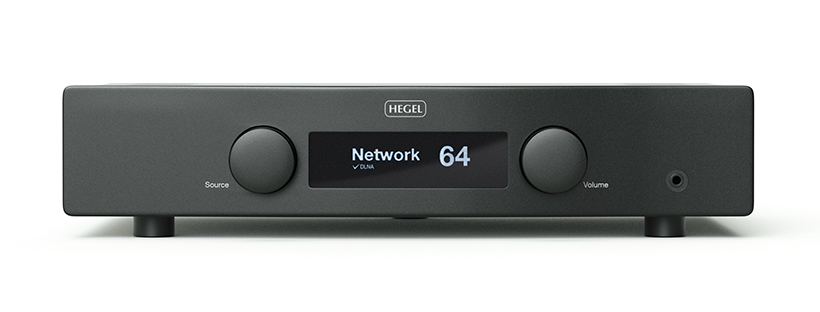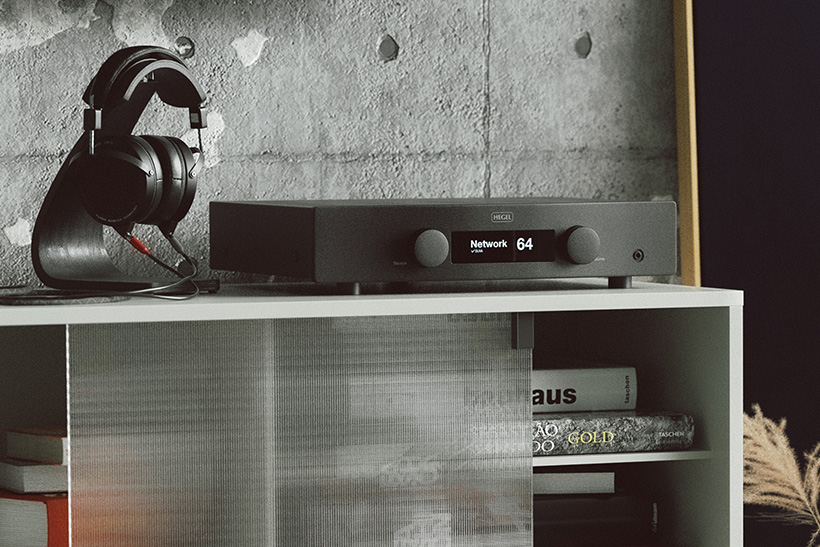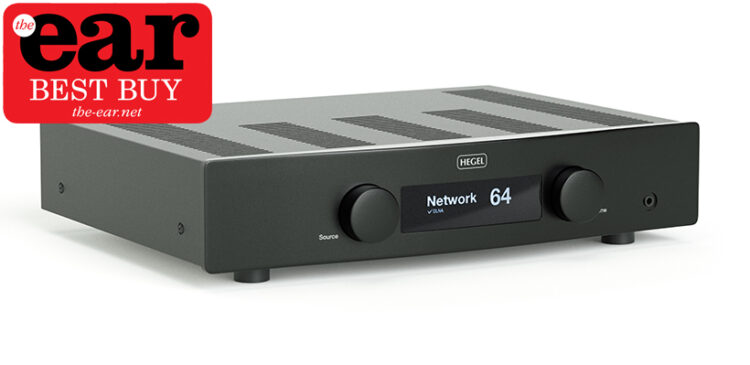The Hegel story begins in 1988 when Bent Holter, a student at the Technical University in Trondheim, prepared his thesis on transistor amplifier design. He quickly discovered that enemy number one was distortion. Holter could not accept the fact that when we supply a simple signal to an amplifier, the output reproduces that signal plus distortion from the electronics.
Overcoming distortion is very hard to do and is rarely achieved, and most efforts in that direction tend to affect other parameters, including the damping factor. Holter decided to break away from classic solutions and developed a project that became Hegel’s SoundEngine Technology. He then took his new company’s name from the band he played in and built amplifiers for, The Hegel Band, who in turn presumably got it from the German philosopher.
After patenting his design he went on to develop a DAC and then his first CD Player before creating a wider range of audio electronics embracing integrated, pre- and power amplifiers. Along with that initial, ground-breaking circuit design, there are now six further exclusive technical solutions in Hegel’s portfolio and the brand has become well-known around the globe.
Technology
A souped-up advancement of the popular H90 model (itself successor to the H80), we have here an integrated amplifier, DAC and streamer capable of 60W per channel with six digital and two analogue inputs (an RCA and one balanced on XLRs), Apple AirPlay, built-in Spotify Connect, UPnP streaming, a headphone socket (boasting better quality and lower-noise) and output to drive a separate power amp. Add to this the lovely remote control as well as upgradable software and we have a package which is so much more than just an amp. Add a pair of reasonable loudspeakers and you have a complete high-end music system offering digital resolution up to 24 bit, 192kHz (96kHz USB). When asked why the H95 has relatively low digital resolution on the USB input by modern standards Hegel’s Anders Ertzeid explained “There is a very good and fairly inexpensive USB receiver that we use. We have used it for years on the entry models, due to its easy implementation and very good sound. We could obviously have updated it, but think most people actually use the network connection, and adding 192k capability without losing performance would add significant cost”.

That SoundEngine design is now in mark two form, offering almost immeasurable signal to noise levels. The design’s damping factor of over 2,000 is some 20-times more than that of comparable products, so little wonder that the bass performance is awesome: dynamic, agile, powerful, responsive and tight. So many improvements have been made to the old H90 that it’s impossible to list them all. Among the most crucial are: a completely new digital circuit with improved DAC as well as improvements in the analogue stages not least the preamp section.
Controls
When the H95 arrived I coupled my faithful Harbeth M30.1s, noted for needing a bit of oomph to get them going. They proved no obstacle for the Hegel. Then ATC’s entry-level SCM7s came, again not the most sensitive on the block, but again no difficulty for the H95. Finally I tried Diapason’s new Micra III Excel small two-ways and they also seemed the perfect match. I even used the H95 as a preamp to drive my Trigon monoblocks into the Harbeths and, yet again, all was well – proving that the electronics inside are versatile and unfussy when it comes to transducer matching. That’s always a very good start for an amplifier. At each stage, the obvious improvements of using a more sophisticated speaker were evident in showing more weight, an improved soundscape with greater holography of image, and more air along with more refined tonal structures.
Most of the time I sat with iPhone in-hand to stream over my network using AirPlay. Android users can download Mplayer, Bubble UpNP or another app offering support, and access their music that way. Spotify users are in for a treat, and it could not be easier because the H95 appears in the list of the App’s audio sources. Bingo!
The H95’s rear panel allows connection of other digital and analogue sources as well as USB and an Ethernet port. Yes, there’s no phono stage – but many of us have long ditched vinyl records while aficionados who wish to spin disks will want to use their own, pet RIAA stage anyway. Built-in internet radio would be an advantage, but this is an entry-level product, not a GLX model.

The front of the matt black case is dominated by an easy-to-read OLED display showing source selected, sample frequency, volume level and menu. To one side is a source selector and to the other another rotary knob which controls volume. In reality, though, neither need be used because of the comprehensive remote handset supplied which operates over a long distance and is one of this product’s attributes. The on/off switch (which isn’t because it puts the unit into ‘sleep’ mode rather than ‘off’) is hidden underneath the front panel; but again the remote is a far easier option but the switch is there for a full power down.
User-programmable options include configuration of each input to cater for home theatre bypass as well as setting switch-on and max volume levels by using an upgrade remote which is standard with the more expensive H190 and, to my mind, is not as pleasant to operate as the dinky plastic one which comes with the H95.
Sound quality
The immediate sensation is of completeness of sound and a reproduction of exceptional quality: bass drum beats are tight and snares snappy. Dynamics are clearly superb through the creation of a rock-solid soundstage with instruments placed with pinpoint precision, something rarely if ever found at this price point. Yes, the H95 can be pushed too far by asking it to do the ridiculous and drive loudspeakers needing much more power and headroom. In that respect my reference H120 is the product to select. But I never found the H95 wanting in the various sensible pairings I used for this review. I lived with the new Hegel coupled to my main speakers for many weeks and enjoyed a wide repertoire including a great deal of radio and TV broadcasts via satellite. I then moved it to my office where it powered a pair of modest monitors on my desk and proved invaluable as more and more meetings became Zoom affairs during the coronavirus pandemic.
The bass performance is clearly worthy of special note for its fullness across the spectrum and also smoothness while remaining natural sounding to create a realistic presentation. Queen’s Don’t Stop Me Now had my feet tapping as the H95 proved its pace, rhythm and timing credentials as well.
Midrange response is crucial to me, not least because of the speech material I listen to but also music from acoustic instruments. Here, again, Hegel have managed a truly competent design with high levels of transparency enjoyed as I sat back for Zubin Varla and Olivia Ross’ performances in the new BBC Radio drama ‘Also Sprach Zarathustra’. The voices were sublimely reproduced and natural-sounding, without hint of chestiness, nasality or sibilance to spoil the production. Undoubtedly, my warm-sounding Harbeth speakers benefit from the Hegel balance when sometimes they are over-driven by amps which possess a warm characteristic of their own.

Rather than being a manufacturer that feels compelled to add a ‘character’ to its electronics Hegel believes in re-creating the recorded sound as the studio engineer intended it; thank goodness I say. This amp also does a good job at smoothing the rough edges of some older recordings, notably I found some ADD performances which I cherish (Sir David Willcocks on EMI and Britten conducting Britten on Decca) but are all too easily rendered harsh by some amplifiers. Detail exudes from the H95 as the listener is treated to a most realistic creation of the soundscape, transporting us to the recording venue in a compelling way; such it was with Wagner’s Parsifal (with Domingo from 2005 on DG) being simply serene with the amplifier maintaining the tonality without trying to flatter or diminish it. Instead, I was presented with a smoothness of balance and nuance which epitomises this monument of sound in all its glory.
Upbeat, pop compositions were equally at home when decoded and amplified by the H95 as my feet tapped away to Cyndi Lauper’s Time After Time and other female vocalists from the 20th century. Each was portrayed with a deep perspective, this Hegel has a clear ability to handle pace and timing with consummate ease, creating a three-dimensional soundstage which was rhythmically engaging with deep and dominating basslines.
Finally I plugged in my Sennheiser HD25 headphones (nothing fancy, but a broadcaster’s mainstay) to discover that the Hegel can generate a decent output for private listening as well. The noise floor is exceptionally quiet and the signal a rich sonic experience which would lead to happy hours of ‘phone listening for those who enjoy this intimate escapade.
Conclusion
Already a Hegel convert, the H95 did not fail to please and proves something of a bargain by packing so many features and streaming options into one modestly-priced package. The sound is transparent, bass performance magnificent and that DAC is to die for. Clearly and audibly an upgrade from the already-good H90, coupled with some decent loudspeakers this all one needs for a highly enjoyable and revealing music system. Clearly the new Hegel H95 is an allrounder which gets so much right, and more than would usually be expected at this price. Another winner.


